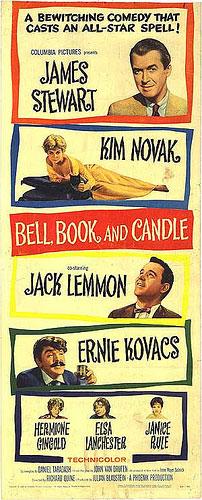Glances at Undervalued Classics: Bell, Book and Candle (1958)
Published 12:00 am Thursday, January 8, 2009

- Glances at Undervalued Classics: Bell, Book and Candle (1958)
The names Jimmy Stewart and Kim Novak and the year 1958 will always go together due to their teaming in Alfred Hitchcock’s legendary Vertigo. Hitchcock’s film has indeed cast such an imposing shadow, that it is often forgotten that it wasn’t the only film the iconic pair made together that year. While not the cinematic milestone that Vertigo is, Richard Quine’s delightful Bell, Book and Candle has for too long been unrecognized has one of the fifties most original, essential, and enduring films.
Bell, Book and Candle started out life as a stage play by John Van Druten. Written in the early part of the fifties, and probably inspired a bit by the Veronica Lake film I Married A Witch, Drutten’s play ran for over a year on Broadway with Rex Harrison and Lili Palmer as its leads.
Optioned by Columbia in the mid fifties, Drutten’s play was transformed into a gem of a screenplay by Daniel Taradash, who was on a bit of a roll with both From Here To Eternity (1953) and Picnic (1955) recently under his belt. Columbia, excited about Taradash’s script, gave the project to a prolific if still young director, and the wheels began turning on the film in the mid part of 1957.
27-year-old director Richard Quine had been making films since the late part of the forties, but had yet to make a big name for himself in the industry by 1957. A one-time child actor, the talented Quine was probably best known at this point for the noir Pushover (1954) and the Judy Holliday vehicle The Solid Gold Cadillac (1956). Quine was the perfect choice for Bell, Book and Candle, as he was incredibly skilled in comedy, romance and mystery, so Drutten’s genre bending play seemed tailor made for him to bring to the screen.
Casting began shortly after Quine was brought on, and the film was granted a relatively generous budget as Columbia felt they might have a hit in the making. Rex Harrison was either unavailable, or not considered, and the great Jimmy Stewart was brought in to replace him as the literally beguiled male lead, Shep Henderson. With the much loved Stewart secured, the rest of the cast began falling into place with some of the best players of the day. Comedic hurricanes Ernie Kovacs and Hermione Gingold were hired, as was the always-reliable Elsa Lanchester. A young television actress named Janice Rule was secured as Stewart’s hapless fiancée Merle, and the soon to be legendary Jack Lemmon was brought in for what would turn out to be one of the strangest roles of his career. All that was left for the studio and Quine was to find someone to play the lonely and trouble witch Gillian Holroyd, and the production could begin.
Viewed today, it is impossible to think of anyone other than Kim Novak as Gillian in Bell, Book and Candle. She fits the part so perfectly that it is hard to believe there was ever any question about the casting. Still, some other actresses were considered for the plum part but at Quine and Stewart’s urging, Columbia finally gave the part to the then 24 year old studio player who had made such a big splash in the Taradash scripted Picnic just two years earlier.
Cast in place, the cameras began rolling on location in New York City in February of 1958. Shot in some of the most beautiful color ever seen on the big screen by legendary cinematographer James Wong Howe, Bell, Book and Candle is one of the great New York films of the fifties, and one of the most distinctive looking films ever made.
Howe was already in his mid fifties when he shot Quine’s great romance, but his work on Bell, Book and Candle is that of an excited and experimental young man firing on all creative cylinders. The film is a wonder to look at, with its brilliant bold brushstrokes of blue, lavender, purple and red and it makes one yearn for the days of Technicolor. One shot in particular of a hat falling off the Flat Iron Building on a freezing, and quite early, Manhattan morning is one of the most beautiful shots of New York City ever committed to celluloid.
Bell, Book and Candle works so wonderfully well in a number of varying genres. It is a romance but, with its many spells and incantations, it is also more than a bit spooky. It’s also very funny, and one of the great undervalued Christmas movies ever. It’s also a wonderful snapshot of the fifties beatnik period as Hollywood saw it, with the film’s beautifully designed Zodiac Club filling in for every existential romantic fantasy one might have of the period nicely.
The cast all appear, with one exception, to be having the time of their lives. Novak and Stewart got on nicely during both this shoot and their time with Hitchcock, and they both deliver warm and touching performances. Quine and Novak were falling in love during this period, and that no doubt helped him film her in many of the films longing and bewitching close ups of her face and eyes.
Kovacs, Gingold and Lanchester are all used to their maximum effect here as well, with special mention going to Kovacs very funny portrayal of a burned out writer who thinks he has the inside track to Manhattan’s witch population. The great Lemmon is the one who doesn’t seem totally engaged. It isn’t surprising as later he would call his role as Gillian’s brother one of the most disappointing of his career. He isn’t bad here, but he just seems distant. His performance is the one dull spot on an otherwise remarkably shiny and near perfect work.
Bell, Book and Candle would open on Christmas day in 1958 to healthy business and fairly solid reviews. It would receive two Academy Award nominations for its set direction, and the wonderful Jean Louis outfits that Novak wore so well. Howe was somehow ignored for his brilliant work, as were the never nominated Quine and Novak. The film would also receive a Golden Globe nomination for Best Picture, but it failed to take home any awards.
Seven years after its release, a television series called Bewitched started and became an immediate sensation. Its tale of a lovely blond witch named Samantha, who marries a mortal, was clearly inspired by Bell, Book and Candle, and it gives the film an interesting cultural counterpoint that still resonates to this day.
Bell, Book and Candle has never really gone away, but it often seems to sit just under the radar of many film fans. Available on VHS since the earliest days of the format, the film is currently available on an ok DVD that features a decent widescreen transfer but no extras. A truly restored print showing Howe’s invigorating color photography would be quite mind blowing, and any extras afforded to the film would be most appreciated.
Richard Quine would sadly take his life in 1989, and he has never gotten his due as a filmmaker. Innovative with talent to burn, Quine’s best films show him as one of the most original directors that came out of Hollywood’s most underrated period. Bell, Book and Candle is Quine’s best film, a cool Christmas Valentine that has never been matched for style, grace, and heart.
Jeremy Richey is a student at W.K.U. who earned his English Degree and is working towards another in History. He has a lifelong interest in film and music and writes daily on his favorites at mooninthegutter.blogspot.com
He also has a side project dedicated to the neglected career of Nastassja Kinski at nostalgiakinky.blogspot.com Visit him at www.myspace.com/jeremy_richey





